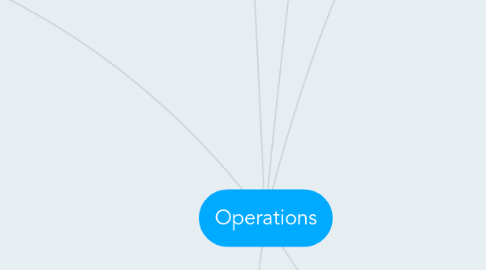
1. Methods of production
1.1. Job productrion
1.1.1. when a product is made individuly to meet specific needs
1.1.2. labour intensive
1.1.3. Advantages
1.1.3.1. it meets the customers needs and is produced to their own specifications
1.1.3.2. high customer satisfaction
1.1.3.3. high prices can be charged as product is unique
1.1.3.4. more motivation for workers as they see the product through all stages of production
1.1.4. Disadvantages
1.1.4.1. high labour cost as the process is labour intensive
1.2. Batch production
1.2.1. this is a group of identify products are made at one time
1.2.2. workers usually specialise in one job so become skilled in one week
1.2.3. Advantages
1.2.3.1. costs less
1.2.3.2. workers are specialised
1.2.3.3. can make more product
1.3. Flow production
2. Quality
2.1. All businesses must ensure they provide a good quality product or service which meets customer needs in order to survive
2.2. The businesses must decide minimum quality levels and who is responsible for ensuring that quality is maintained at the lowest possible cost
2.3. Advantages of ensuring quality
2.3.1. Repeat purchases
2.3.2. Improved reputation
2.3.3. Competitive advantage
2.3.4. Maxamize sales/profits
2.3.5. Increased market share
2.3.6. Reduced wastage
2.4. Methods of ensuring quality
2.4.1. High quality raw materials
2.4.1.1. This will ensure that only the best inputs are used in your production and lead to higher quality product
2.4.1.2. However the costs of these materials may be higher and reliable supplier is required
2.4.2. High quality employees
2.4.2.1. Fewer errors are made and accidents are less likely to happen
2.4.2.2. However it can be time consuming and expensive to train employees
2.5. Methods of ensuring quality
2.5.1. Quality control
2.5.1.1. Quality control is the checking of a product or service by carrying out an inspection
2.5.1.2. This usually happens at the end of the production process
2.5.1.3. `This is less time consuming than other methods of inspecting quality
2.5.1.4. May lead to large amounts of waste as it is only checked at the end
2.5.2. Quality management
2.5.2.1. Quality management is a method by which a business focuses on ensuring the product is made perfectly every time. this requires commitment by all employees
2.5.2.2. Samples of products are tested at random and at different stages of the production process.
2.5.2.3. However it requires commitment from everyone
2.5.2.4. Products constantly checked to minimize waste
2.5.2.5. More thorough than other methods
2.5.2.6. Improves teamwork and morale
2.5.2.7. Policies take time to implement and must be strictly followed
3. Ethical and environmental
3.1. Businesses are required to be socially responsible.
3.2. Means they will be seen in a positive way by not harming the local environment or community
3.3. Businesses can:
3.3.1. Try to minimize wastage by ensuring employees are trained, ensuring machinery is kept in good condition and by not overstocking. Could be expensive
3.3.2. Recycle as much as possible by encouraging employees to put rubbish in appropriately coloured bins and by reusing materials in the production process as much as possible
3.3.3. Try to minimise packaging by only using the necessary amount of packaging to maintain the products quality. cut costs. good for environment.
3.3.4. Prevent pollution by watching the materials it uses in production (e.g. fuel and chemicals) and by dispensing of any harmful chemicals or products in the most environmentally friendly way.
4. Choosing a supplier
4.1. Price
4.1.1. The price charged by a supplier for raw materials. Cheaper price, will reduce costs, increase profits and improve cash flow.
4.2. Quality
4.2.1. How good the raw materials are. High quality raw materials means high quality products. Low quality leads to wastage.
4.3. Delivery Time
4.3.1. How long it takes to receive after ordering raw materials. If the supplier is late production could stop. some are perishable
4.4. Reputation
4.4.1. Will the supplier deliver when they say?
4.5. Location
4.5.1. How far away is the supplier? Transport costs may need to be considered.
4.6. Quantity
4.6.1. How much required.
5. Management of stock
5.1. 3 main types of stock
5.1.1. Raw materials
5.1.1.1. Purchases from suppliers, waiting to be used
5.1.2. Work in progress
5.1.2.1. Products that are currently being made (semi-finished-goods)
5.1.3. finished goods
5.1.3.1. Completed products waiting to be distributed
5.2. Costs
5.2.1. Storage space
5.2.2. Boxes
5.2.3. Security
5.2.4. Transport
5.2.5. Refrigerators/Freezer
5.2.6. Polystyrene
5.2.7. Storage unit
5.2.8. Heating
5.2.9. Taxes
5.2.10. Insurance
5.3. Risks
5.3.1. Too little
5.3.1.1. production might stop
5.3.1.2. Customers may not receive their orders on time.
5.3.1.3. Any sudden increase in demand cannot be met
5.3.2. Stock has a higher risk of:
5.3.2.1. Being stolen
5.3.2.2. Going out of date
6. 3 stages
6.1. Input
6.1.1. factors of production
6.2. Process
6.2.1. Manufacturing
6.3. Output
6.3.1. Finished product and distribution
6.4. Role of operations
6.4.1. making products. this can involve people or machinery.
6.4.2. satisfying customers by making a product that they want.
6.4.3. Working with suppliers to ensure raw materials are available at the correct time.
6.4.4. Managing levels of stock to make sure nothing runs out
6.5. Too much
6.5.1. Costs money to to store i.e. warehouse, lighting, security, insurance.
6.5.2. Money which is tied up in stock might be put to better use
6.5.3. If social factors change (trends/fashions, the stock might be wasted.
6.6. Choosing a supplier
6.6.1. Price
6.6.1.1. The price charged by a supplier for raw materials. Cheaper price, will reduce costs, increase profits and improve cash flow.
6.6.2. Quality
6.6.2.1. How good the raw materials are. High quality raw materials means high quality products. Low quality leads to wastage.
6.6.3. Delivery Time
6.6.3.1. How long it takes to receive after ordering raw materials. If the supplier is late production could stop. some are perishable
6.6.4. Reputation
6.6.4.1. Will the supplier deliver when they say?
6.6.5. Location
6.6.5.1. How far away is the supplier? Transport costs may need to be considered.
6.6.6. Quantity
6.6.6.1. How much required.

